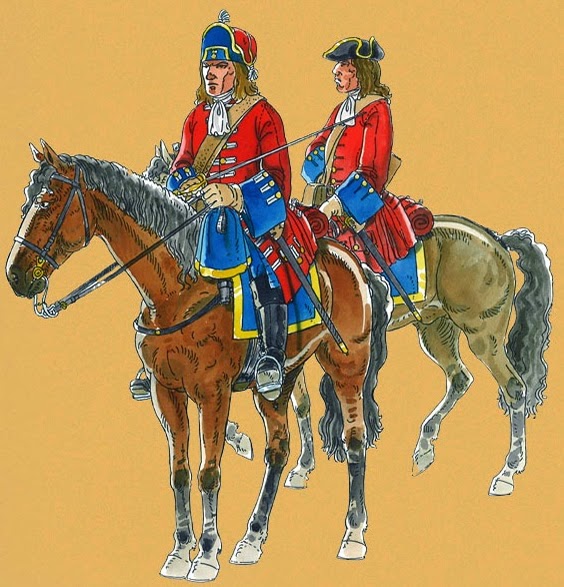 |
| War of the Spanish Succession |
The War of the Spanish Succession (1701–14) was a great European conflict fought over which claimant would assume the vacant throne of Spain.
Throughout the 16th century, Spain had been ruled by the Habsburg dynasty, which also controlled Austria and other parts of Europe. Charles II (1661–1700), the last Habsburg king of Spain, had no legitimate heir. He named Philip, duc d’Anjou (1683–1746), as his successor.
The Bourbon dynasty, which ruled France, had been long-standing rivals of the Habsburgs; the closest claimant to the Spanish throne was Louis XIV’s eldest son with Maria-Theresa. However, the princess had been barred from her rights to the Spanish throne as part of her marriage contract.
  |
This condition was contingent upon receipt of the bride’s dowry, which was never paid. Since the promotion of Louis XIV’s son to the Spanish throne would unite the thrones of both France and Spain and certainly prompt a reaction from the European powers, Louis XIV advocated that his younger grandson, duc d’Anjou, rule Spain.
Leopold I (1640–1705), Holy Roman Emperor, king of Austria, and member of the Habsburg family, attempted to preserve his family’s control of Spain by forwarding himself as the rightful successor to Charles II. Such a situation would unite the thrones of Austria and Spain, a situation unacceptable to the European powers, and Leopold I advocated his son, Archduke Charles (1685–1740), as king of Spain.
Expanding French Influence
 |
| Milan regiment (Spanish) |
The son of Leopold I’s daughter, Prince Joseph Ferdinand of Bavaria (1692–99), was the preferred candidate as king of Spain by the European powers, who feared either family’s gaining too much dominance. Prince Joseph Ferdinand was agreed upon as heir in 1698, but he died of smallpox in 1699. England then ratified the Treaty of London (1700) recognizing Archduke Charles as heir to the Spanish throne.
Charles II died in 1700. He declared the duc d’Anjou his successor and Louis XIV quickly declared his grandson Philip V king of the Spanish empire. England could not afford war with France and recognized Philip V as king of Spain in 1701.
Louis XIV attempted to solidify his newfound influence by severing both England and the Netherlands from Spanish trade. The blow to both countries’ commercial interests forced them into an alliance with Austria against France and Spain.
The Treaty of the Hague (1701) of the Netherlands, England, and Austria recognized Philip V as king of Spain but transferred sections of Italy and the Netherlands under Spanish rule to Austria. It also confirmed England’s and the Netherlands’s commercial rights in Spain.
The war began in 1702, when Austrian forces invaded Spanish territories in Italy, forcing French intervention. England, the Netherlands, and several German states sided with Austria while Bavaria, Portugal, and Savoy supported France and Spain. Other opportunist states joined sides in the conflict, expanding fighting throughout Europe and North America, where the conflict became known as Queen Anne’s War.
 |
| The Royal Regiment of Dragoons circa (spanish) |
The duke of Marlborough captured territories in the Netherlands in 1702–03 while Prince Eugene held French forces in Italy. The French, under the duc de Villars, scored a victory at Friedlingen in 1702. Success in Alsace, located between France and the Holy Roman Empire, presented the opportunity for an invasion of Austria in 1703, but dissention among French commanders ruined this opportunity.
Marlborough moved his troops from the Netherlands to Bavaria, linking with Prince Eugene’s forces to defeat the French at the Battle of Blenheim (1704). Meanwhile, Portugal and Savoy switched sides, joining the coalition headed by England, Austria, and the Netherlands. In 1704, England captured the strategic island of Gibraltar.
 |
| The French, under the duc de Villars, scored a victory at Friedlingen in 1702 |
French Invade Italy
In 1706, French forces evacuated Italy following Prince Eugene’s victory at Turin and the Netherlands following Marlborough’s victory at Ramillies. In 1708, following Prince Eugene’s disastrous expedition into Provence the previous year, Marlborough and Eugene won at Oudenarde and captured Lille.
French forces retreated, losing an additional battle at Malplaquet (1709). Allied campaigns in Spain (1708–10) garnered little success in weakening Philip V’s position. Louis XIV opened peace negotiations, but his refusal to join against his grandson brought negotiations to a halt.
In 1711, the death of Holy Roman Emperor Joseph I (1678–1711) resulted in the ascension of Archduke Charles (Charles VI) to the thrones of Austria and the Holy Roman Empire. The English opened negotiations to end the war.
   |
The Treaty of Utrecht (1713) ended hostilities among France, Spain, England, and the Netherlands. Charles VI continued the war, finally ending hostilities by signing the Treaties of Rastatt and Baden (1714), which complemented the general settlement of the Treaty of Utrecht.
Philip V retained the Spanish throne under the condition that he and his descendants were barred from the throne of France. Austria gained territory in Italy and the Netherlands previously belonging to Spain while England gained Gibraltar, Minorca, and exclusive rights to slave trading in Spanish America for 30 years.
France recognized Anne as queen of England and surrendered some of its American territories. France’s dominance over the European continent was checked and the notion of the preservation of the balance of power emerged as the cornerstone of European politics for centuries to come.
 |
| The Battle of Malplaquet. This Pyrrhic victory began to revive French fortunes in the war. |